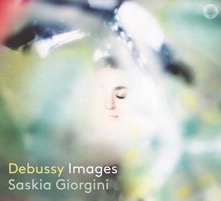Le musicologue belge Harry Halbreich (1931-2016) disait, à juste titre : Le piano occupe une position centrale dans la création debussyste. Dans la lignée des grands pianistes compositeurs, Debussy (1862-1918) s’inscrit tout naturellement dans la succession de Mozart, Beethoven, Schumann, Chopin et Liszt. Si l’on trouve après lui Bartók, Prokofiev, Messiaen, auteurs d’une importante production pianistique, il s’en faut cependant qu’elle occupe dans l’ensemble de leur œuvre une place aussi considérable. Il n’en est que plus étonnant de constater que, seul parmi ses pairs, Debussy a affirmé sa personnalité créatrice au piano beaucoup plus tard que dans les autres domaines de composition. Tant par la qualité, que par la quantité, son œuvre pianistique est essentiellement de maturité." La pianiste Saskia Giorgini propose ici une palette d’œuvres incontournables, comme "Danse, Tarentelle styrienne" L.69, "Deux Arabesques" L.66, "Nocturne en ré bémol majeur" L.82, "Pour le piano" L.59, "Estampes" L.100, "Images" Livre 1, L.110, et Livre 2, L.111, ainsi que "L’Isle joyeuse" L.106. Un programme au minutage généreux (83mn), pour une interprétation sensible, faisant penser à ce que disait Marguerite Long, grande pédagogue s’il en fut, du jeu du compositeur français : "Comment oublier la souplesse, la caresse, la profondeur de son toucher ! Il jouait presque toujours en demi-teinte, mais avec une sonorité pleine et intense." Saskia Giorgini, c’est tout cela avec quelque chose en plus.... à découvrir sans tarder.
Jean-Jacques Millo The Belgian musicologist Harry Halbreich (1931-2016) quite rightly stated: “The piano occupies a central position in Debussy’s creativity. In keeping with the great pianist-composers, Debussy (1862-1918) naturally follows Mozart, Beethoven, Schumann, Chopin and Liszt. Although we find after him Bartók, Prokofiev, Messiaen, all authors of an important pianistic catalogue, it nevertheless does not occupy such a considerable place in their work as a whole. It is all the more surprising to note that, alone among his peers, Debussy asserted his creative personality on the piano much later than in other areas of composition. Both in quality and quantity, his pianistic work is essentially mature. Pianist Saskia Giorgini offers here a range of essential works, such as “Dance, Styrian Tarantelle” L.69, “Deux Arabesques” L.66 , “Nocturne in D flat major” L.82, “For the piano” L.59, “Estampes” L.100, “Images” Book 1, L.110, and Book 2, L.111, as well as “L ’Isle Joyeuse” L.106. A generously timed program (83 minutes) for a sensitive interpretation reminiscent of what Marguerite Long, a great teacher if ever there was one, said of the French composer’s playing: “How can one forget the flexibility, the caress, the depth of his touch! He almost always played in a subdued tone, but with a full and intense sound.” Saskia Giorgini is all this and more... to discover without delay.
Translation Lawrence Schulman |  |